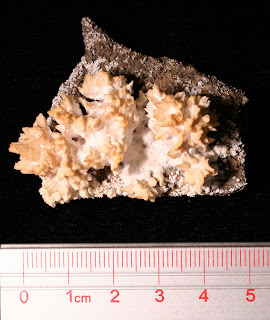Picture of a bryozoan attached to
Whitfieldella brachiopod from the Silurian Waldron Shale of Clark County, Indiana. Unfortunately, part of the byrozoan fossil was destroyed when I tried to clear some the matrix encrusting it with a sand abrasive cleaner. My artificial sand storm swept across this 400 million year old fossil and disintegrated the surface features of the fossil colony in an instant. Despite my efforts of trying to pulse clean this very small area, the flow rate was too high. Hopefully, I will find another colony and be much more careful on how it is cleaned. See next picture.
Exactly what this fossil was called had been bouncing around in my mind for a couple weeks.While paging through
The Fossil Book, I came across a picture of the Devonian
Flabellotrypa rugulosa found in Tennessee. Some information about the
Flabellotrypa can be found in R. Bassler's paper on bryozoan.
R.S. Bassler describes a bryozoan
Flabellotrypa as, "Like
Sagenella,
but zooecia open only along outer edge of the incrusting flabelliform
zoarium. More or less circular attached disks about 3.5 mm wide, of
parallel, contiguous, transversely striated tubes. Type species:
F. rugulosa"
Next step was to determine what the
Sagenella was. This piece of the puzzle would be found in the 1881 Indiana Geological Survey and its coverage of fossils of the Waldron Shale. James Hall describes the
Sagenella elegans as:
Bryozoum a thin membraniform expansion growing upon the surface of other organic bodies. Cells subcylindrical, flattened for the greater portion of their length and continuing nearly parallel with the plane of the epitheca; arranged in a more or less diverging or radiating order, with intercalated ranges, presenting a subimbricated aspect, turning abruptly and opening upward. Cell-apertures circular, about two millimeters in diameter.
The arrangement of cells and form of cell-apertures differ from CERAMOPORA in the rounded form and more directly upward opening. The genus differs from LICHENALIA in the more extended procumbent portion of the cell-tube, in the form of the cell-aperture, and in the much thinner and persistently adhering epitheca.
 |
| Ceramopora labecula Bryozoan - Plate 7 Figure 1 Indiana Geological Survey 1881 |
James Hall names 6 species of
Ceramorpora in the 1881 Geological survey. One, the
Ceramorpora labecula is described here:
Bryozoum growing in circular or subcircular discoid forms upon other organic bodies; greatest diameter observed about seven millimeters. Cell-tubes short, cylindrical, radiating from the center and increasing by lateral additions, those in the central portion being nearly vertical, and becoming more and more oblique as they recede from this point, until the marginal ones are nearly parallel with the epitheca; arranged in alternating and imbricating series. Apertures arched or somewhat triangular, .25 mm., or less, in diameter.
This species is found attached to the bases of crinoids, to gasteropods, and other fossils.
These last pictures show the fossil specimen first where it has been cleaned and second before it was cleaned. It is interesting as one can see the bryozoum started at one point on the brachiopod and began growing in wavy line across the shell. Eventually one reached an ideal spot in the feeding current and multiplied out into a subcircular form.
Scales should have been included on the pictures but I did not photograph them. Brachiopod is about 2 cm wide and 2.2 cm long. The bryozoan is about 1 mm wide.
Sources:
Fenton, Carroll L, and Mildred A. Fenton.
The Fossil Book: A Record of Prehistoric Life. Garden City, N.Y: Doubleday 144 (1958)
Annual Report of the Geological Survey of Indiana. Indianapolis Plate (1881)
Bassler, R.S.
Taxonomic notes on genera of fossil and Recent Byrozoa, U.S. National Museum, Journal of The Washington Academy of Sciences 42:381-385 (1952)

















































